The ocean is full of life, and ocean plants are a big part of it. These sea plants help marine animals live, breathe, and find food. From tiny algae to long strands of kelp, they grow in all shapes and sizes. Some float, while others stay rooted to the sea floor. They play a big role in keeping the ocean healthy.
You’ll find many kinds of ocean plants in warm and cold waters. Some live near the shore, while others grow deep underwater. People often search for ocean plants names to learn more. Pictures help too, so ocean plants names and pictures are often used together. These plants found in ocean are not just pretty they also give us oxygen and protect the environment. If you’re curious about one special ocean plant or want to know them all, this list of 18 types is a great place to start.
18 Types of Plants Found in the Ocean
18 Types of Plants Found in the Ocean grow in different shapes, colors, and sizes. These ocean plants include seagrasses, kelp, and algae. Each plays a big role in marine life. Many ocean plants even help clean the water naturally.
From shallow shores to deep sea beds, ocean plants thrive in unique ways. They give food and shelter to sea animals. These ocean plants also make oxygen for us to breathe. Learning about them helps us protect nature and the ocean better.
1. Kelp
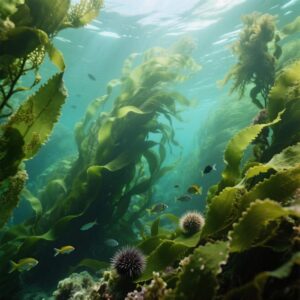
- Description: Kelp is a large brown seaweed growing in underwater forests.
- Habitat: It lives in shallow, cold oceans with lots of sunlight and nutrients.
- Physical Characteristics: Long, ribbon-like fronds with air bladders to float toward sunlight.
- Diet/Nutrition: Makes its own food using sunlight through photosynthesis like land plants.
- Ecological Role: Provides shelter, food, and oxygen for many marine animals and plants.
- Reproduction: Reproduces through spores released into water from special parts called sori.
Kelp is a large green algae that grows in underwater forests. It’s one of the fastest-growing sea plants, reaching up to two feet per day in ideal conditions.
You can find kelp along cold, nutrient-rich coastlines. It thrives especially in places like the Pacific Coast and North Atlantic Ocean, where sunlight and strong currents support its growth.
Kelp has long, leaf-like blades, sturdy stipes, and root-like holdfasts that anchor it to the sea floor. Air bladders keep its blades floating toward sunlight.
It’s an important food source for marine animals like sea urchins and fish. Many coastal communities also harvest kelp for human use.
Kelp plays a huge role in marine ecosystems by providing shelter, reducing coastal erosion, and helping store carbon dioxide from the atmosphere.
It reproduces through spores, spreading new plants across the sea floor without needing seeds or flowers like land plants.
Kelp is used in food, cosmetics, and medicine. Its extracts thicken products, add nutrients, and support sustainable industries worldwide.
Read More: Leaf Sheep (Costasiella kuroshimae): A Complete Overview
2. Seagrass
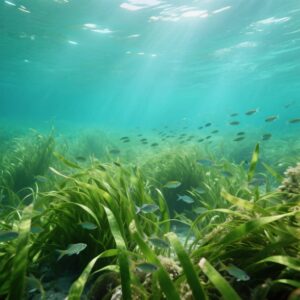
- Description: Seagrass is a flowering ocean plant that looks like grass but lives underwater.
- Habitat: It grows in shallow coastal waters, especially in sandy or muddy seabeds near sunlight.
- Physical Characteristics: Seagrass has long, narrow green blades and spreads through roots called rhizomes.
- Diet/Nutrition: It makes food through photosynthesis using sunlight, carbon dioxide, and water.
- Ecological Role: Seagrass provides shelter, oxygen, and food for many marine animals and maintains sea floor stability.
- Reproduction: It reproduces by releasing pollen in water and spreading through rhizome growth.
Seagrass is a flowering plant that grows underwater in shallow coastal waters. It forms large meadows that provide food and shelter for fish, turtles, and other marine animals.
These plants need sunlight, so they grow close to shore. Clear, shallow waters help seagrass photosynthesize. Strong roots anchor them into the sandy sea floor, keeping them safe from strong currents.
Seagrass plays a big role in cleaning the water. It traps dirt and absorbs extra nutrients, keeping the marine environment balanced. This makes it an important natural filter for oceans.
It’s also a vital food source. Sea turtles, manatees, and many fish species rely on seagrass for nutrition. Healthy meadows mean more food for these marine animals.
Seagrass helps protect shorelines from erosion. Its roots hold the sand together, reducing the impact of waves and storms. This natural barrier keeps coastal areas safer.
These plants store carbon, helping fight climate change. By absorbing carbon dioxide, seagrass meadows reduce greenhouse gases and support cleaner air for all living things.
Sadly, pollution, boating, and climate change damage seagrass habitats. Protecting these plants ensures healthy oceans, strong marine ecosystems, and a safer planet for future generations to enjoy.
3. Green Algae
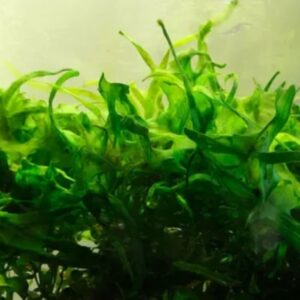
- Description: Green algae are simple ocean plants that look like soft green patches or strands underwater.
- Habitat: They grow in shallow coastal waters, freshwater ponds, and even in moist land areas.
- Physical Characteristics: They are usually bright green, soft, slimy, and can be filamentous, leafy, or sheet-like.
- Diet/Nutrition: They make their food using sunlight through photosynthesis, absorbing nutrients from the water.
- Ecological Role: Green algae produce oxygen, support marine life, and help maintain a healthy aquatic environment.
- Reproduction: They reproduce by fragmentation, binary fission, or releasing spores depending on species and conditions.
Green algae are simple plants found in oceans, rivers, and lakes. They are bright green because of chlorophyll. These plants play a big role in making oxygen and feeding marine life.
They grow in shallow waters where sunlight is strong. Green algae attach to rocks, shells, or sand. Some types can even float freely. Their growth depends on clean water and enough nutrients.
These plants can be tiny, single-celled species or larger, leafy forms. Many green algae look like seaweed. Their soft, flexible bodies make them move gently with the waves in the ocean.
Green algae make their own food through photosynthesis. They take in sunlight and carbon dioxide to produce oxygen and sugars. This process helps the underwater ecosystem stay balanced and healthy.
Many marine animals eat green algae. Fish, turtles, and snails rely on them for energy. They are also important food for tiny creatures like plankton.
Green algae help clean the water by absorbing excess nutrients. They can also prevent harmful bacteria from spreading. Healthy algae growth often means the ocean is in good condition.
Humans use green algae for food, medicine, and cosmetics. They are rich in vitamins and minerals. In some places, they’re even used in farming as natural fertilizers.
4. Red Algae (Rhodophyta)
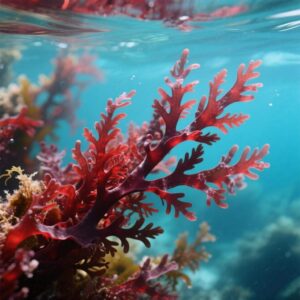
- Description: Red Algae are soft or crusty sea plants with reddish pigments from phycoerythrin.
- Habitat: They live on rocks in shallow tropical waters and sometimes in deep cold ocean zones.
- Physical Characteristics: They appear red or purple, with flat or branching fronds depending on the species.
- Diet/Nutrition: They use photosynthesis to make food using sunlight, water, and carbon dioxide.
- Ecological Role: Red Algae support marine life by producing oxygen and building coral reef ecosystems.
- Reproduction: They reproduce through spores, fragmentation, or gametes, often without needing water for fertilization.
Red algae, also called Rhodophyta, are among the oldest groups of sea plants. They have a red pigment called phycoerythrin, which helps them absorb blue light in deeper waters.
They grow mostly in warm, tropical oceans but can also be found in colder seas. Many species attach themselves to rocks, shells, or coral reefs, forming dense underwater growth.
Red algae play a big role in marine ecosystems. They provide food and shelter for fish, sea urchins, and other marine life, keeping the underwater world in balance.
Some red algae have calcified structures. These hard parts help build and stabilize coral reefs, making them important reef builders in shallow tropical waters and intertidal zones.
People use red algae for various products. It’s a source of agar and carrageenan, ingredients in foods, cosmetics, and medicines around the world.
Red algae reproduce in different ways. They can use spores, fragmentation, or sexual reproduction, adapting to changing ocean conditions for survival.
These plants also act as environmental indicators. Healthy red algae growth often means clean, nutrient-rich waters, while their decline can signal pollution, climate change, or harmful changes in marine ecosystems.
5. Diatoms
- Description: Diatoms are single-celled ocean plants with glass-like shells made of silica.
- Habitat:
They live in oceans, freshwater, and moist soils, mostly floating near the surface. - Physical Characteristics: They have symmetrical shapes and hard, clear cell walls called frustules.
- Diet/Nutrition: Diatoms use photosynthesis to make food, needing sunlight, water, and carbon dioxide.
- Ecological Role: They produce oxygen, support marine food chains, and help reduce carbon dioxide in oceans.
- Reproduction: Diatoms reproduce by binary fission and sometimes form spores under harsh conditions.
Diatoms are tiny, single-celled algae found in oceans, rivers, and lakes. They are important for marine life. These microscopic plants form the base of many aquatic food chains.
They have unique cell walls made of silica, giving them beautiful, glass-like shells. These shells have intricate patterns. This makes diatoms one of the most fascinating microscopic organisms to study.
Diatoms use sunlight for photosynthesis. They turn carbon dioxide into oxygen, making them vital for our planet’s oxygen production. This process supports marine animals and even impacts global climate.
These algae live in both saltwater and freshwater. They can float freely or attach to surfaces like rocks, shells, or plants. Their adaptability helps them thrive in different aquatic environments.
Diatoms reproduce mainly through cell division. Sometimes, they also use sexual reproduction when conditions change. This ensures their population remains healthy and stable over time.
They play a major role in the nutrient cycle. When they die, their silica shells sink, helping store carbon in deep ocean sediments. This reduces greenhouse gases.
Diatoms are also used in industry. Their silica shells help make products like filters, toothpaste, and even gentle cleaning agents. This shows their value beyond marine ecosystems.
6. Mangroves
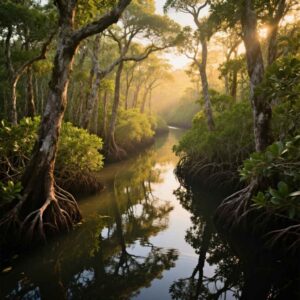
- Description: Mangroves are salt-tolerant ocean plants with tangled roots growing along tropical and subtropical coasts.
- Habitat: Found in intertidal zones, thriving where seawater meets land in warm coastal regions.
- Physical Characteristics: Tall trees with dense roots, waxy leaves, and specialized roots for breathing in waterlogged soil.
- Diet/Nutrition: Make food through photosynthesis, using sunlight, water, and carbon dioxide from the surrounding environment.
- Ecological Role: Provide shelter for marine animals, prevent coastal erosion, and store carbon to fight climate change.
- Reproduction: Spread by floating seeds, called propagules, which germinate while still attached to the parent tree.
Mangroves are unique coastal trees and shrubs that grow in salty waters. They have special roots that rise above the ground. These roots help them breathe and survive in low-oxygen mud.
You can find mangroves in tropical and subtropical regions. They grow along shorelines, estuaries, and river mouths. Their tangled roots provide shelter for fish, crabs, and many marine animals.
Mangroves protect coastlines from erosion and storm surges. Their roots trap sediment, keeping the water clear. This helps coral reefs and seagrass beds stay healthy and full of life.
These trees are also important for storing carbon. Mangroves capture more carbon per area than most forests. This makes them valuable in fighting climate change and protecting our planet.
Mangroves reproduce by producing seedlings called propagules. These float in water until they find a suitable spot to grow. This clever adaptation helps mangroves spread across coastal areas efficiently.
7. Coraline Algae
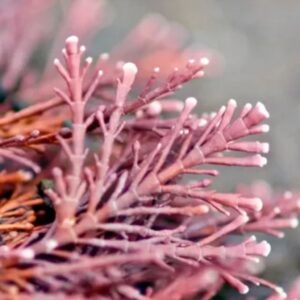
- Description: Coraline algae are hard, red algae with calcium-rich structures that strengthen marine ecosystems.
- Habitat: Found in shallow tropical oceans, coral reefs, and rocky coastal areas worldwide.
- Physical Characteristics: Pink to red colors, calcified fronds, and rough textured surfaces.
- Diet/Nutrition: Absorbs nutrients from seawater and uses sunlight for photosynthesis.
- Ecological Role: Builds reef structures, supports marine biodiversity, and prevents coastal erosion naturally.
- Reproduction: Reproduces through spore-based reproduction and fragmentation for quick growth.
Coraline algae are hard, pink or red marine plants that grow on rocks and reefs. They’re important in building reef structures and helping protect coastlines from waves and erosion.
These algae have a tough surface because they store calcium carbonate. This makes them strong and perfect for creating stable marine habitats for fish, shellfish, and other small sea creatures.
You can find coraline algae in tropical and subtropical oceans around the world. They often live in shallow waters where sunlight reaches them for photosynthesis.
They play a key role in marine ecosystems. Coraline algae help bind reefs together, provide surfaces for corals to grow, and encourage healthy biodiversity in the ocean.
Coraline algae reproduce using spores. They can grow slowly but are long-lasting. Protecting them from pollution, climate change, and ocean acidification is essential for keeping reefs and marine habitats healthy.
8. Sargassum
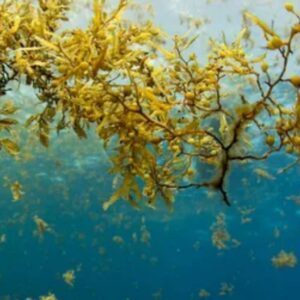
- Description: Sargassum is a floating brown seaweed forming large mats on the ocean surface.
- Habitat: Found mostly in the Sargasso Sea, tropical waters, and along warm ocean currents.
- Physical Characteristics: Has leafy fronds, small round air bladders, and a brown to golden color.
- Diet/Nutrition: Absorbs nutrients directly from seawater through its fronds for photosynthesis and growth.
- Ecological Role: Provides shelter and breeding grounds for fish, turtles, and many marine animals.
- Reproduction: Spreads mainly by fragmentation, where broken pieces grow into new plants.
Sargassum is a type of brown seaweed that floats freely on the ocean surface. It often forms large mats, creating a unique habitat for fish, crabs, and other small marine creatures.
It is commonly found in the Sargasso Sea and tropical waters. Sargassum can also drift to beaches, where it sometimes piles up in large amounts, affecting coastal communities and tourism.
This seaweed has small air-filled bladders that help it stay afloat. Its branches are covered with leafy structures, giving shelter and food to many species in the open ocean.
Sargassum plays an important role in marine ecosystems. It offers breeding grounds for marine animals and contributes to nutrient cycles, supporting life far from shore.
However, excessive growth caused by pollution and climate change can create problems. Large blooms can block sunlight in coastal waters, harm marine habitats, and cause unpleasant smells when washed ashore.
9. Fucus
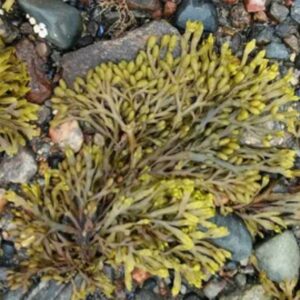
- Description: Fucus is a flat, brown seaweed with air bladders that help it float.
- Habitat: Found on rocky coasts in cold and temperate oceans worldwide, especially intertidal zones.
- Physical Characteristics: Thick, leathery fronds with branching tips and small round air pockets for buoyancy.
- Diet/Nutrition: Makes food through photosynthesis using sunlight, water, and carbon dioxide from the environment.
- Ecological Role: Provides shelter and food for marine animals, and protects shorelines from erosion.
- Reproduction: Reproduces through spores released in water during specific tidal and seasonal conditions.
Fucus is a brown seaweed found along rocky shorelines in cooler coastal waters. It’s easy to spot with its olive-green color and thick, flat fronds. Many people know it as rockweed or bladderwrack.
This seaweed grows in the intertidal zone, where it’s exposed during low tide and covered during high tide. Fucus attaches itself firmly to rocks using strong holdfasts, making it resistant to strong waves and currents.
Its fronds have small air-filled bladders, which help them float toward sunlight for photosynthesis. These bladders are round and scattered across the fronds, giving Fucus its distinctive look. The texture feels rubbery when touched.
Fucus is rich in nutrients like iodine, calcium, and vitamins. It has been used for centuries in traditional medicine. Today, it’s also used in health supplements, cosmetics, and even as fertilizer for farming.
This seaweed plays an important ecological role. It provides shelter for small marine creatures and supports coastal food webs. Fucus also helps prevent coastal erosion by stabilizing rocky shorelines with its dense growth.
10. Sea Lettuce
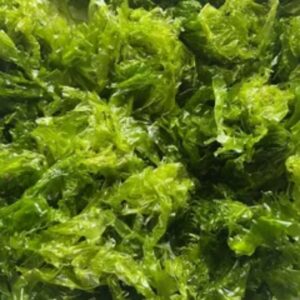
- Description: Sea Lettuce is a bright green seaweed with thin, leafy, lettuce-like fronds.
- Habitat: Found in shallow coastal waters, especially in nutrient-rich areas near shores and estuaries.
- Physical Characteristics: Soft, flat, and translucent leaves that wave gently with ocean currents.
- Diet/Nutrition: Absorbs nutrients directly from surrounding seawater through its leaf-like surfaces.
- Ecological Role: Provides food and shelter for marine animals and acts as a pollution indicator.
- Reproduction: Reproduces through spores released into the water, spreading quickly in favorable conditions.
Sea Lettuce is a bright green seaweed found in oceans worldwide. It grows in shallow waters and attaches to rocks or shells. Its scientific name is Ulva lactuca, and it’s known for its thin, leafy texture.
This plant is rich in vitamins and minerals, making it popular as a healthy food. People eat it raw in salads or dried as a snack. Its mild, salty taste is enjoyed in many coastal cuisines.
Sea Lettuce plays an important role in marine ecosystems. It gives shelter to small marine animals and helps keep water clean. It can also grow quickly, which makes it useful for environmental restoration projects.
It thrives in nutrient-rich waters but can also indicate pollution if it grows in large amounts. Scientists use its presence to study water quality and coastal health.
Sea Lettuce reproduces through spores, spreading easily in the right conditions. Its simple structure and adaptability make it one of the most common sea plants in the world.
11. Caulerpa
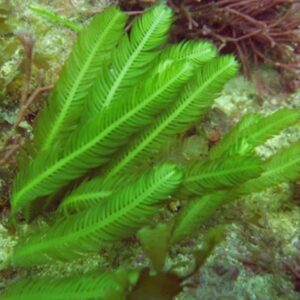
- Description: Caulerpa is a fast-growing green algae with long, feather-like fronds under the sea.
- Habitat: Found in warm tropical waters, often covering sandy seabeds and rocky ocean floors.
- Physical Characteristics: Bright green fronds with stolons connecting each plant, creating dense underwater carpets.
- Diet/Nutrition: Absorbs nutrients directly from seawater, using sunlight for photosynthesis to create its own food.
- Ecological Role: Provides shelter for marine animals and helps stabilize sandy coastal environments.
- Reproduction: Spreads through fragmentation, where broken pieces grow into new plants, allowing rapid colonization.
Caulerpa is a bright green seaweed that grows in tropical and subtropical oceans. It’s known for its feather-like fronds. This marine plant is both beautiful and useful in underwater environments.
It thrives in shallow coastal waters with sandy or muddy bottoms. Caulerpa spreads quickly, covering large areas. This makes it a strong competitor against other marine plants and algae.
Caulerpa plays an important role in marine ecosystems. It provides shelter for fish and small sea creatures. Its dense growth also helps stabilize sandy sea floors and reduce erosion.
This seaweed reproduces in two ways: by releasing gametes or through fragmentation. Even a small piece can grow into a new plant, which makes it very adaptable.
Caulerpa is sometimes used in aquariums and as food in certain cuisines. However, some species can become invasive, harming native plants and changing the balance of local ecosystems.
12. Halimeda
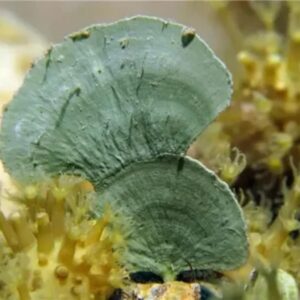
- Description: Halimeda is a green algae with calcified segments that look like small, flat coins.
- Habitat: Found in tropical waters, especially near coral reefs and sandy sea floors.
- Physical Characteristics: Hard, chalky texture due to calcium carbonate in its leaf-like segments.
- Diet/Nutrition: Performs photosynthesis, using sunlight to produce its own food from carbon dioxide.
- Ecological Role: Helps build reef structures and provides habitat for small marine animals.
- Reproduction: Reproduces by releasing gametes into the water, often during specific lunar cycles.
Halimeda is a unique green algae found in warm tropical waters. It has a segmented, leaf-like shape. This plant is important for coral reefs, adding beauty and structure to the underwater world.
It grows in shallow coastal areas, often among coral reefs. Halimeda attaches to rocks or sand with small root-like parts. Its presence shows a healthy marine environment with clear, nutrient-rich waters.
Halimeda has a special ability to store calcium carbonate in its body. This makes it strong and helps build reef structures. The green color comes from chlorophyll used in photosynthesis.
Small marine animals use Halimeda for shelter. It also plays a role in producing sand when it breaks down. This sand supports beaches and other coastal areas naturally.
Halimeda reproduces both sexually and asexually. It can release spores into the water or grow from broken pieces. This helps it spread quickly in suitable environments.
13. Eelgrass
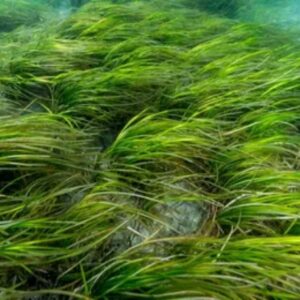
- Description: Eelgrass is a green underwater plant forming large meadows in shallow coastal waters.
- Habitat: Found in sandy or muddy bottoms in temperate and subtropical ocean regions worldwide.
- Physical Characteristics: Long, ribbon-like leaves that sway gently with ocean currents, providing shelter for sea life.
- Diet/Nutrition: Produces energy through photosynthesis, using sunlight, water, and carbon dioxide for growth.
- Ecological Role: Supports marine biodiversity, improves water quality, and stabilizes sea floor sediments naturally.
- Reproduction: Reproduces by seed formation and by spreading underground stems called rhizomes.
Eelgrass is a flowering plant that grows underwater in shallow coastal areas. It looks like long green ribbons. This sea plant forms large underwater meadows, creating homes for fish, crabs, and other marine animals.
Eelgrass thrives in sandy or muddy bottoms. It prefers clean, clear waters with plenty of sunlight. Strong currents and healthy nutrient levels help it grow well. It’s often found in bays, estuaries, and lagoons.
This plant plays a big role in marine ecosystems. It stabilizes the sea floor, reducing erosion. It also provides oxygen and food, supporting a wide range of marine life in coastal waters.
Eelgrass reproduces through seeds and by spreading its rhizomes underground. This allows it to form wide meadows quickly. Healthy eelgrass beds show that water quality and marine environments are in good condition.
Eelgrass is important for humans too. It supports fisheries, protects shorelines, and improves water clarity. Protecting eelgrass habitats helps keep oceans healthy and full of life.
14. Spirulina
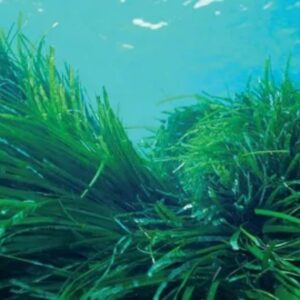
- Description: Spirulina is a blue-green algae rich in protein, vitamins, and essential minerals.
- Habitat: Grows naturally in warm, alkaline waters of lakes and shallow tropical oceans.
- Physical Characteristics: Microscopic, spiral-shaped filaments with a vibrant blue-green color.
- Diet/Nutrition: Consumed as a health supplement for protein, antioxidants, and omega fatty acids.
- Ecological Role: Produces oxygen, supports aquatic food chains, and helps maintain water quality.
- Reproduction: Multiplies quickly through binary fission in favorable warm and nutrient-rich waters.
Spirulina is a type of blue-green algae found in both fresh and salt water. It’s known as a superfood because of its high protein, vitamins, and minerals content, making it popular worldwide.
This algae grows naturally in alkaline waters, especially in warm, tropical climates. Today, it’s also farmed in artificial ponds for large-scale production, ensuring a steady supply for food and supplements.
Spirulina is a nutritional powerhouse, rich in antioxidants and essential amino acids. People often consume it as powder or tablets. It’s easy to add to smoothies, juices, and even baked goods.
In the environment, spirulina acts as an oxygen contributor through photosynthesis. It supports marine biodiversity and helps maintain a healthy nutrient cycle in aquatic environments.
Spirulina reproduces quickly through binary fission, making it easy to grow. Its pharmaceutical potential continues to be studied, showing promise in boosting immunity and supporting overall health.
15. Mermaid’s Fan
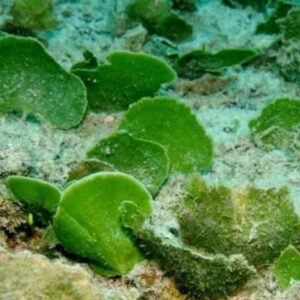
- Description: Mermaid’s Fan is a green algae shaped like a flat, circular fan.
- Habitat: Found in tropical waters, especially on sandy seabeds and coral reefs.
- Physical Characteristics: Grows up to 6 inches tall with a stiff, fan-shaped frond.
- Diet/Nutrition: Absorbs nutrients from seawater through photosynthesis for energy.
- Ecological Role: Provides shelter for small marine life and helps stabilize sandy bottoms.
- Reproduction: Spreads by releasing spores and fragments that grow into new plants.
Mermaid’s Fan is a unique type of green algae found in warm, shallow ocean waters. Its flat, fan-shaped fronds make it look like a piece of underwater art. Divers often notice it near coral reefs.
This plant thrives in sandy and rocky seabeds. It’s commonly found in the Caribbean Sea, Gulf of Mexico, and tropical Atlantic regions. Mermaid’s Fan grows best in clear, nutrient-rich waters with plenty of sunlight.
Mermaid’s Fan plays an important role in marine ecosystems. It offers shelter for small marine creatures like crabs and shrimp. It also helps stabilize the sea floor, preventing erosion in coastal areas.
Its fronds are stiff and often covered with a thin layer of calcium carbonate. This makes them stronger and less appealing to marine herbivores. The bright green color comes from chlorophyll used for photosynthesis.
Mermaid’s Fan reproduces by releasing spores into the water. This helps it spread to new areas. It grows slowly but can live for many years.
16. Sea Palms (Postelsia)
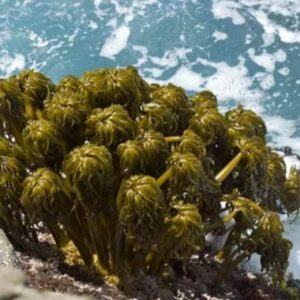
- Description: Sea Palms are brown ocean plants that look like miniature palm trees swaying in waves.
- Habitat: Found on rocky Pacific Coast shores, especially in strong surf zones with constant wave action.
- Physical Characteristics: Tall, flexible stipes with leafy fronds; pneumatocysts help them stay upright in water.
- Diet/Nutrition: Perform photosynthesis, using sunlight, water, and carbon dioxide to make their own food.
- Ecological Role: Provide shelter and food for marine animals, helping maintain healthy coastal ecosystems.
- Reproduction: Spread by releasing spores into the water, allowing new plants to grow on rocks.
Sea Palms (Postelsia) grow along rocky shorelines in the Pacific Coast. They stand tall like miniature palm trees. These marine brown algae are strong and flexible, surviving powerful waves that crash against their coastal homes.
They are most common in the intertidal zones. Sea Palms cling tightly to rocks using holdfasts. During low tide, they remain upright, waiting for the water to return, which keeps them healthy and alive.
Their physical structure includes a sturdy stem-like stipe and long, narrow blades. The blades sway in the water, capturing sunlight for photosynthesis. This process gives them energy and supports surrounding marine life.
Sea Palms play an important role in coastal ecosystems. They provide shelter for small marine animals and contribute to nutrient cycles. Their presence also helps protect shorelines by reducing wave energy in certain areas.
They reproduce using spores, which spread through ocean currents. This ensures new plants grow nearby. Their unique appearance and adaptability make Sea Palms a fascinating example of marine biodiversity.
17. Turtle Grass
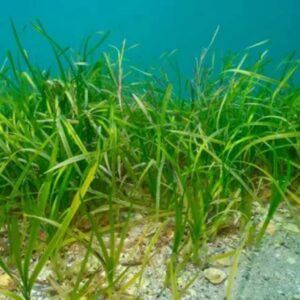
- Description: Turtle Grass is a green seagrass forming dense underwater meadows in shallow coastal waters.
- Habitat: Found in tropical and subtropical seas, especially in sandy bottoms near coral reefs.
- Physical Characteristics: Long, flat, ribbon-like leaves reaching up to 14 inches in length.
- Diet/Nutrition: Produces food through photosynthesis, providing nutrients for marine herbivores like turtles and manatees.
- Ecological Role: Supports marine biodiversity, stabilizes sea floors, and improves water clarity in coastal areas.
- Reproduction: Reproduces through flowering and seed production, and also by spreading via rhizomes underground.
Turtle Grass is a type of seagrass found in warm, shallow waters. It grows in sandy seabeds and forms dense underwater meadows. These meadows provide food and shelter for many marine creatures, including turtles.
This seagrass has long, flat, ribbon-like leaves that sway gently in ocean currents. Turtle Grass leaves can grow up to 14 inches long. Their green color comes from chlorophyll, which helps in photosynthesis.
Turtle Grass plays a big role in keeping marine ecosystems healthy. It helps trap sediment, keeping the water clear. Its roots stabilize the seabed, preventing coastal erosion and protecting shorelines from damage.
Marine animals like turtles, manatees, and sea urchins eat Turtle Grass. Small fish and crustaceans use it as a safe hiding place. It’s an important part of the ocean’s food chain and habitat network.
Turtle Grass reproduces in two ways—by spreading through underground stems or producing seeds. Healthy meadows mean healthy marine life, making their conservation vital.
18. Padina
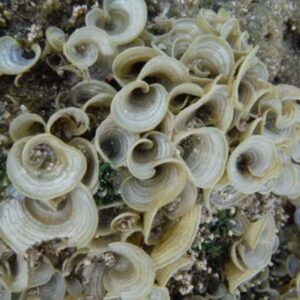
- Description: Padina is a small, brown marine algae shaped like a delicate, curled fan.
- Habitat: Found in shallow tropical and subtropical waters attached to rocks or coral reefs.
- Physical Characteristics: Has fan-shaped fronds with visible growth rings and a soft, brownish texture.
- Diet/Nutrition: Absorbs nutrients directly from seawater through its fronds using photosynthesis.
- Ecological Role: Provides shelter for small marine animals and helps maintain healthy marine ecosystems.
- Reproduction: Reproduces through spores, using both sexual and asexual methods depending on environmental conditions.
Padina is a type of brown algae found in warm seas around the world. It’s also called peacock’s tail because of its fan-like shape and delicate, curved fronds.
This algae usually grows in shallow tropical and subtropical waters. You can find it attached to rocks, coral reefs, or sandy seabeds. Its preferred habitat has plenty of sunlight for photosynthesis.
Padina has soft, brown fronds with visible white growth rings. These fronds curl slightly, giving them a graceful, shell-like appearance. The texture is smooth, and they sometimes collect fine sand on the surface.
It plays an important role in marine ecosystems by providing shelter for tiny marine animals. Padina also helps stabilize seabeds and supports a healthy environment for other sea plants and marine life.
Padina reproduces through spores, using both sexual and asexual methods. Its simple structure and adaptability make it a common and resilient species in coastal regions.
What Are the Most Common Plants in the Ocean?
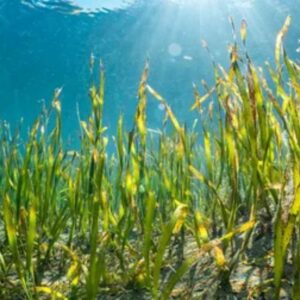
The most common plants in the ocean include kelp, seagrass, sea lettuce, and various algae species. These plants grow in shallow waters, support marine life, and produce oxygen. They also help protect coastlines, making them vital to ocean health and balance.
- Phytoplankton: Tiny ocean plants that float in the water and produce oxygen through photosynthesis. They’re a vital ocean plant group, serving as food for many marine animals. These sea plants are diverse, with thousands of ocean plants names recorded worldwide.
- Kelp (Laminariales): Giant ocean plants forming underwater forests. These plants found in ocean grow up to 200 feet tall. They provide shelter for fish, store carbon, and are a key ocean plant for healthy marine ecosystems.
- Seagrasses: Flowering ocean plants living in shallow waters. They stabilize the sea floor and produce oxygen. Common ocean plants names and pictures show types like eelgrass and turtle grass, which are important habitats for fish, turtles, and other marine life.
- Diatoms (Bacillariophyta): Single-celled ocean plants with glass-like shells. These plants found in ocean are major oxygen producers. Their ocean plants names are countless, and they form the base of many marine food chains.
- Marine Algae Diversity: Includes green, red, and brown ocean plants. These sea plants have countless ocean plants names and pictures. They feed marine herbivores and produce oxygen while supporting coral reef ecosystems and other marine habitats.
- Mangroves: Coastal ocean plants growing in salty, shallow waters. These plants found in ocean protect shorelines, reduce erosion, and support fish nurseries. They are among the most valuable sea plants for sustaining marine biodiversity and healthy ecosystems.
FAQ’S
What do plants in the sea need to survive?
They need sunlight, water, and nutrients to grow. Ocean Plants also need the right temperature and healthy marine conditions to stay alive.
How do sea plants produce oxygen?
They use photosynthesis to make oxygen from sunlight and carbon dioxide. This process keeps marine life and humans breathing.
Can sea plants live in deep waters?
Some can survive in low light using special adaptations. Most grow in shallow waters where sunlight easily reaches them.
Why are sea plants important for marine animals?
They give shelter, food, and breeding areas for many species. Without them, marine ecosystems would lose balance and biodiversity.
Do humans use plants from the sea?
Yes, people eat them, make medicine, and use them in beauty products. They also provide materials for various everyday items.
Conclusion
Ocean Plants are a vital part of life under the sea. They give oxygen, food, and shelter to countless marine animals. These plants keep the water clean and help protect coastlines from erosion. From large kelp forests to tiny phytoplankton, each has its own role. Many sea plants also support human life by providing food, medicine, and useful materials.
Learning about these plants helps us understand the ocean better. It also reminds us why we must protect marine habitats. Climate change, pollution, and overfishing harm these plants and the creatures that depend on them. By caring for the ocean, we help both sea plants and ourselves. Healthy oceans mean more oxygen, cleaner water, and stronger ecosystems. Every small step to protect nature counts. Let’s keep the oceans full of life and beauty for future generations to enjoy.

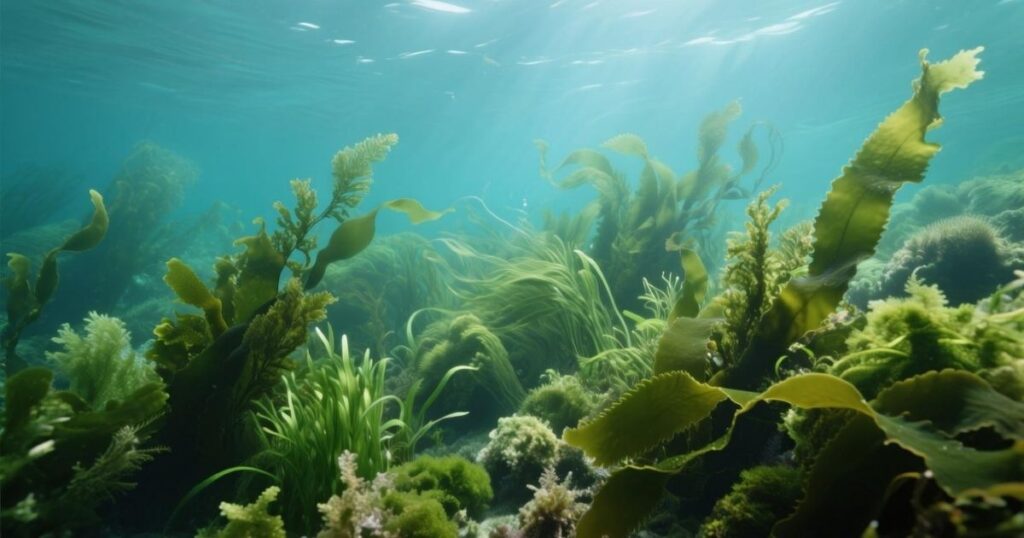
1 thought on “18 Different Types of Ocean Plants”